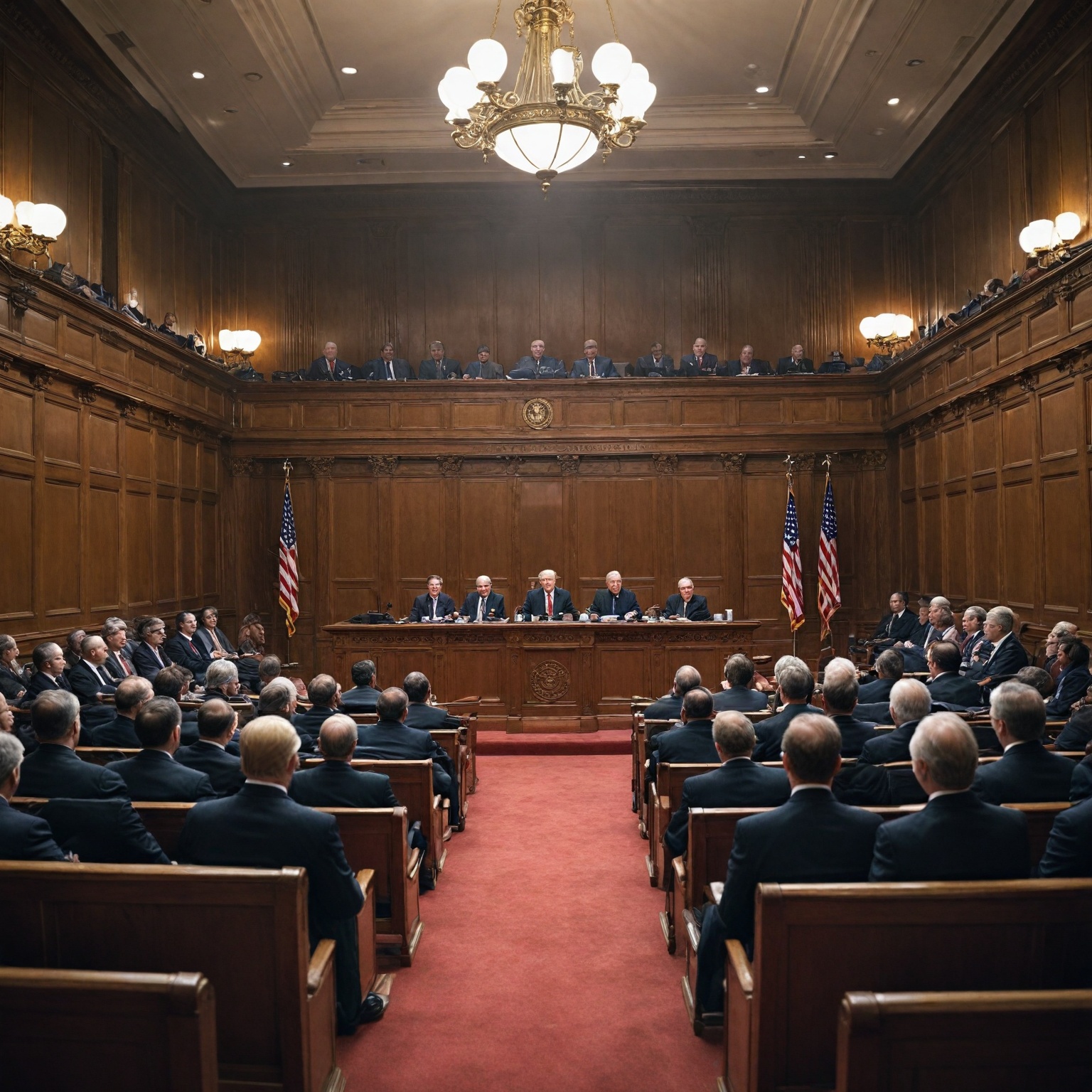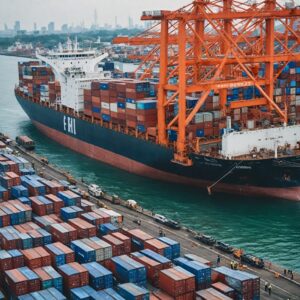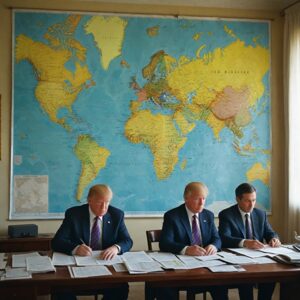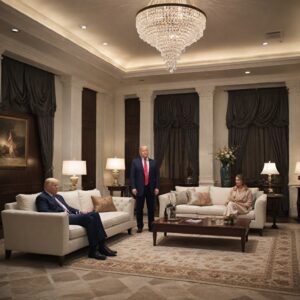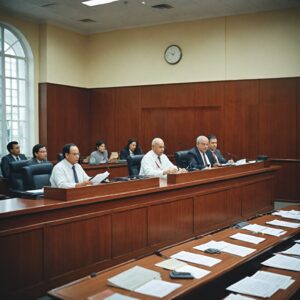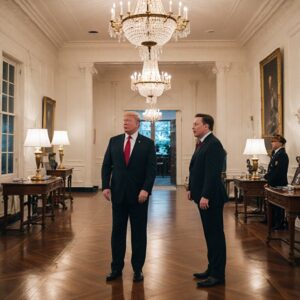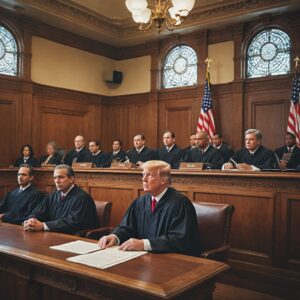Summary
During the second presidency of Donald Trump, the United States implemented a sweeping series of protective tariffs that significantly increased import duties on a broad range of goods, including steel, aluminum, and products from the European Union and China. These tariffs, designed under provisions such as Section 232 of the Trade Expansion Act and the International Emergency Economic Powers Act (IEEPA), aimed to address perceived national security risks and trade imbalances but led to heightened tensions with key trading partners and disrupted global supply chains. Among the most contentious measures were the so-called “reciprocal” tariffs—across-the-board levies applied at varying rates on imports from multiple countries, including a 20% tariff on European goods announced in April 2025.
Legal challenges quickly followed, with states, businesses, and advocacy groups contesting the administration’s authority to impose these tariffs without explicit congressional approval. Central to these disputes was the unprecedented use of IEEPA to justify tariffs, a move that critics argued overstepped constitutional boundaries by expanding executive power beyond established limits on trade legislation. In a landmark decision on May 26, 2025, the U.S. Court of International Trade blocked enforcement of the “reciprocal” tariffs, ruling that the president had exceeded statutory and constitutional authority, and underscoring Congress’s exclusive power over international commerce. This judicial intervention marked a significant check on unilateral executive trade actions and sparked debate over the future of tariff-setting powers in the United States.
The court’s ruling had immediate economic repercussions, triggering a surge in European stock markets, particularly benefiting sectors vulnerable to U.S. tariffs such as the automobile industry. While the suspension of tariffs eased short-term market uncertainty and temporarily cooled retaliatory measures from the European Union, concerns remained over the broader economic impact of the tariffs on global growth, inflation, and trade relations. Diplomatic responses were mixed: European leaders cautiously welcomed the pause as an opening for negotiations but warned that punitive tariffs could be reinstated if talks failed, while U.S. officials framed the tariffs as necessary tools to protect domestic industries despite the ongoing legal battles.
This episode highlights the complex interplay between executive authority, judicial oversight, and international diplomacy in shaping U.S. trade policy. The controversy surrounding the Trump tariffs illustrates enduring tensions over the constitutional scope of presidential powers in trade, the economic consequences of protectionist measures, and the fragile nature of global trade relationships amid shifting political landscapes. As legal challenges continue to unfold, the case serves as a critical moment in defining the balance of powers and the future direction of American trade strategy.
Background
During his second presidency, United States President Donald Trump implemented a series of steep protective tariffs affecting nearly all imported goods into the country. Between January and April 2025, the average effective U.S. tariff rate surged from 2.5% to approximately 27%, marking the highest level in recent history. These tariffs targeted a wide range of products, including steel, aluminum, washing machines, solar panels, and various goods from China, cumulatively impacting over $380 billion worth of trade and resulting in an estimated $80 billion increase in taxes on imports.
Among the tariffs introduced were “reciprocal” tariffs, designed as across-the-board taxes applied at varying rates to different countries. On April 2, 2025, Trump announced a 20% levy on imports from the European Union as part of this strategy. In response, the EU member states voted almost unanimously to impose retaliatory tariffs of 25% on €21 billion worth of U.S. agricultural and industrial products, primarily targeting goods originating from Republican-led states. However, the EU opted to delay the implementation of these duties to allow space for negotiations, despite the ongoing presence of U.S. tariffs on steel, aluminum, and automobiles.
The U.S. tariffs were enacted under several statutory provisions, including Section 232 of the Trade Expansion Act of 1962, which permits the president to impose tariffs if imports threaten national security. This provision was a key legal basis for tariffs on steel and aluminum during both of Trump’s terms. The fluctuating and often unpredictable nature of these trade policies, including sudden changes and partial reversals, unsettled global financial markets and heightened trade tensions with key partners and allies.
On May 26, 2025, a significant development occurred when the U.S. Court of International Trade blocked the enforcement of the “reciprocal” tariffs imposed by Trump, creating uncertainty for American importers and ongoing trade negotiations with the EU and China. The Trump administration indicated its intent to appeal the ruling and explore alternative legal avenues to reinstate the tariffs, which contributed to volatility in markets but also optimism among investors in Europe. In parallel, the Biden administration maintained most of the tariffs established by its predecessor but suspended certain levies on imports from the EU and replaced others with tariff-rate quotas, signaling a nuanced approach to trade policy.
Legal Challenges to the Tariffs
The tariffs imposed under the Trump administration have faced numerous legal challenges, many of which argue that the tariffs were unlawfully imposed and economically damaging. One prominent lawsuit led by Oregon Attorney General Dan Rayfield, representing multiple states, characterized the tariffs as unlawful and reckless, emphasizing the widespread negative impact on various businesses ranging from wine importers to manufacturers of educational kits and musical instruments. The judges overseeing this case noted that if the tariffs were deemed unlawful for the plaintiffs, they would be unlawful for all affected parties, highlighting the broad implications of the ruling.
A central legal issue in these challenges is the use of the International Emergency Economic Powers Act (IEEPA) as the statutory basis for imposing the tariffs. This law, traditionally used to grant the president broad economic powers during national emergencies, had never before been employed to justify tariffs until the Trump administration’s actions. The constitutional and statutory validity of using IEEPA for tariff imposition has therefore been subject to intense scrutiny, with several pending lawsuits examining the limits of presidential authority under this law.
Further complicating the legal landscape is the Supreme Court’s recent reconsideration of administrative authority and congressional delegation doctrines. In cases like Loper Bright Enterprises, the Court has questioned the extent to which Congress can delegate legislative powers to the executive branch without overstepping constitutional boundaries. The New Civil Liberties Alliance, a key player in mounting constitutional challenges, has argued that such delegation may infringe upon Congress’s legislative responsibilities, raising questions about the legality of broad executive actions like tariff imposition.
From a judicial perspective, precedent suggests courts are generally deferential to presidential trade actions, especially those involving discretionary powers granted by statutes such as Section 201 of trade law. The Court of Appeals for the Federal Circuit, which has jurisdiction over many trade-related appeals, has held that such actions may only be invalidated in cases of clear statutory misinterpretation, significant procedural errors, or actions exceeding delegated authority. This limited scope of judicial review means that, despite ongoing litigation, immediate business concerns focus more on the tariffs’ economic impact than on protracted legal outcomes.
The complex interplay of these legal challenges, statutory interpretations, and constitutional debates continues to shape the fate of the tariffs and the broader discourse on executive power in trade policy. Meanwhile, at least five other legal challenges remain pending, indicating that the judicial process surrounding these tariffs will continue to evolve in the coming years.
Court Decisions and Judicial Reasoning
Several federal courts have played a pivotal role in challenging and ultimately pausing President Donald Trump’s tariffs, particularly those imposed under the guise of national emergency powers. Central to these rulings is the question of whether the president exceeded statutory and constitutional authority in unilaterally imposing broad tariffs without explicit congressional authorization.
The Court of International Trade, a specialized federal court based in New York, issued a landmark ruling declaring most of Trump’s tariffs illegal, including those on Chinese goods. The court emphasized that the U.S. Constitution grants Congress exclusive authority over international commerce, a power that cannot be overridden by the president’s invocation of emergency powers under the International Emergency Economic Powers Act (IEEPA). The judges noted that while the court does not assess the wisdom or effectiveness of the tariffs, it must enforce constitutional boundaries, thereby issuing a permanent injunction on the blanket tariff orders issued since January of that year. This decision disrupts ongoing trade negotiations with multiple nations and injects uncertainty into supply chains and business planning for countless American companies reliant on imports.
The legal challenges brought by states and businesses argue that the use of IEEPA to impose tariffs represents an unprecedented and unconstitutional expansion of executive power. IEEPA had never before been employed for such a purpose, and critics contend that tariffs are fundamentally legislative matters reserved for Congress, especially given their broad economic impact. The courts have been urged to scrutinize these executive actions under constitutional doctrines such as the nondelegation doctrine, which restricts Congress from transferring its legislative powers too broadly to the executive branch, and the major questions doctrine, which requires clear congressional authorization for decisions of vast economic significance.
The judicial reasoning in these cases reflects a renewed vigor in reevaluating the balance of powers between the legislative and executive branches. For example, dissenting opinions in related Supreme Court considerations have expressed concern over Congress abdicating its legislative responsibilities, while plurality opinions warn that invalidating broad delegations could call into question much of modern governance. The Supreme Court’s impending review of related administrative authority issues will further test the vitality of these constitutional doctrines.
Moreover, the Court of Appeals for the Federal Circuit has underscored the limited role of courts in second-guessing presidential trade actions when undertaken under statutory authority such as Section 201 of the Trade Act of 1974, which allows temporary tariffs to address serious balance-of-payments deficits. The court’s standard for overturning such actions is high, requiring clear statutory misinterpretation, significant procedural errors, or action beyond delegated authority. Nonetheless, the current challenges to Trump’s tariffs under IEEPA raise distinct issues that diverge from past precedents and have resulted in judicial intervention.
Collectively, these court decisions have not only paused the implementation of key tariffs but also highlight the ongoing constitutional debate over the scope of presidential power in trade policy. The rulings have significant implications for the future conduct of U.S. trade relations and the regulatory authority of federal agencies in interpreting and enforcing trade laws, especially in light of recent judicial shifts away from doctrines like Chevron deference that previously granted agencies considerable interpretive leeway.
Market Impact
The U.S. Court of International Trade’s decision to block President Donald Trump’s “reciprocal” tariffs on European imports had an immediate and positive effect on European stock markets. Following the ruling, the pan-European Stoxx 600 index rose by 0.4%, with the majority of sectors showing gains. This rebound was particularly pronounced in the European automobile sector, which is highly sensitive to U.S. tariff threats due to the significance of vehicle and machinery exports to the U.S. German carmakers such as BMW, Mercedes-Benz, and Volkswagen experienced notable increases of 2%, 2%, and 2.6%, respectively.
Investors reacted with relief as the tariffs, which included a broad 10% levy on European imports and additional tariffs on automobiles, remained suspended, reducing immediate cost pressures and uncertainty in trade flows and supply chains. The volatility gauge for the euro zone stock market stayed elevated at 37 points, reflecting persistent concerns over potential market swings despite the positive market response.
However, underlying fears remained that the tariffs, if fully implemented, could adversely impact both the U.S. and global economies by slowing growth and increasing inflation at a time when the Federal Reserve was aiming to curb price rises. Inflation data from March indicated a rise of 2.4% year-on-year, slightly below expectations, underscoring the delicate economic backdrop. Economic analyses projected that Europe could be pushed into recession and U.S. growth could contract by as much as 1.5% due to the tariff shocks, which were substantially more severe than earlier tariff measures paused in April.
The ruling was welcomed by some U.S. officials and legal experts who argued that the president lacked unilateral authority to impose such tariffs without legislative approval. In financial markets, Asian shares and U.S. stock futures rose following the decision, while the U.S. dollar strengthened against traditionally safe-haven currencies like the Japanese yen and Swiss franc. European markets, meanwhile, opened flat but maintained cautious optimism in the face of ongoing trade tensions and the potential for further negotiations between the EU and the Trump administration to reach a mutually beneficial agreement.
Despite the temporary reprieve, the uncertainty created by the erratic nature of the tariff policies continued to weigh on investor sentiment. The frequent shifts in U.S. trade stance served as a reminder of how swiftly market conditions could change, prompting heightened volatility and market sensitivity to political developments. The European Union also maintained its preparedness to implement retaliatory measures, including new tariffs on American goods such as motorcycles, poultry, fruit, and wood, with phased implementation planned if negotiations fail.
Official Reactions and Diplomatic Responses
The announcement of the pause on tariffs by the Trump administration and the European Union’s decision to suspend its retaliatory tariffs elicited a range of official reactions and diplomatic responses across both sides of the Atlantic. European Commission President Ursula von der Leyen expressed cautious optimism, stating that the EU would hold off on implementing its 25% tariffs on €21 billion worth of U.S. goods for 90 days to “give negotiations a chance.” However, she emphasized that if talks did not yield satisfactory results, the EU would proceed with countermeasures and continue to prepare further retaliatory actions. Von der Leyen also highlighted the importance of “clear, predictable conditions” for trade and supply chains to function properly, underscoring the EU’s preference for a balanced and mutually beneficial trade agreement.
Spain’s Prime Minister Pedro Sánchez welcomed the U.S. tariffs pause, describing it as “a door to negotiation and deals between countries,” but also criticized the broader imposition of tariffs by the Trump administration as “unjustified and unjust,” particularly citing the high tariffs placed on countries such as Vietnam. Similarly, France’s President Emmanuel Macron reacted by urging French companies to halt planned investments in the U.S., framing the tariffs as a significant shock to international trade and signaling a firm stance against the trade disruptions.
From the U.S. side, the administration characterized the reciprocal tariffs as a necessary response to foreign countries’ nonreciprocal trade practices, framing the trade deficit as a national emergency that required decisive action. White House officials maintained that the tariff suspensions were a strategic move to open space for negotiations rather than a cancellation of tariffs, with higher duties on certain key products, including steel, aluminum, and automobiles, remaining in effect. The administration’s position highlighted the need to rebalance trade relations and protect American industries, despite criticism and uncertainty from affected companies and international partners.
Economically, the tariff dispute had already contributed to lowered growth forecasts in major European economies such as France, Germany, Italy, and Spain, prompting significant financial support packages from several countries to mitigate the impact on businesses and employment. Market reactions included a reduction in expectations for European Central Bank rate cuts and heightened uncertainty among investors.
Subsequent Developments and Policy Changes
Following the judicial ruling that challenged the Trump administration’s authority to impose certain tariffs without proper legal backing, significant shifts occurred in both U.S. trade policy and international responses. The administration was granted a 10-day window to comply with the judges’ orders, highlighting limitations on the use of the International Emergency Economic Powers Act (IEEPA) in justifying tariffs on specific products such as aluminum and steel. Although some tariffs on automobiles, steel, and aluminum remained in place—being based on different statutory authority—the ruling signaled a judicial check on the executive’s broad tariff powers.
The ruling introduced considerable uncertainty in global markets, impacting consumers and businesses across Europe and beyond. Despite the continuation of higher tariffs on key metals and automobiles, the move was seen by European leaders as a potential opening for renewed negotiations. In response, the European Union, which had planned retaliatory tariffs on approximately €21 billion worth of U.S. agricultural and industrial goods, chose to suspend these levies for a 90-day period to allow diplomatic engagement. This pause followed President Trump’s softened stance, which temporarily eased tensions and led to a surge in European stock markets.
The ongoing trade dispute underscored persistent disagreements over market access and trade fairness, with Washington demanding unilateral concessions from the EU, while Brussels sought mutually beneficial arrangements. The trade wars, characterized by rapid tariff impositions and reversals, have disrupted global supply chains and challenged companies’ strategic planning. Additionally, political debates within the United States intensified over the president’s authority to enact sweeping tariffs, a question that remains central as tariff policies continue to influence economic and
Analysis and Commentary
The recent judicial pause on certain Trump-era tariffs has sparked significant debate regarding the scope of executive authority and its implications for international trade and domestic economic stability. Central to this discourse is the interpretation of the Commerce Clause and related statutory provisions granting the president authority to impose tariffs. Historical and legal scholarship affirms that Congress has delegated broad power to the executive branch to regulate trade across state and international lines, including imposing tariffs to address economic imbalances or unfair trade practices.
From a legal standpoint, the Supreme Court’s decision in Loper Bright Enterprises v. Raimondo marks a pivotal shift by curtailing the longstanding Chevron deference, which had previously required courts to defer to federal agencies’ interpretations of ambiguous statutes within their regulatory domain. This ruling empowers judges to independently interpret laws, potentially increasing judicial scrutiny of executive tariff actions and affecting the speed and certainty with which such measures are implemented.
Economically, the immediate effects of the tariff suspension are evident in market responses, such as the surge in European stocks, reflecting relief among investors wary of escalating trade tensions. The tariffs have already disrupted trade flows and supply chains, with notable impacts on sectors targeted by reciprocal tariffs, including American motorcycles, poultry, fruit, and wood products. European leaders have reacted strongly: European Commission President Ursula von der Leyen indicated preparations for further countermeasures should negotiations fail, while French President Emmanuel Macron called for a pause in French investments in the U.S., underscoring the broader economic shock the tariffs have inflicted on transatlantic commerce.
Politically, the stalemate in U.S.-EU trade negotiations reveals deep-seated disagreements over market access and tariff reciprocity, complicating prospects for a balanced trade agreement. The EU has expressed a preference for negotiations that yield mutual benefits, whereas the U.S. administration has pushed for unilateral concessions, further exacerbating tensions. Despite the possibility for Congress to amend the president’s tariff-setting authority, current political dynamics make such legislative action unlikely in the near term.
In sum, the judicial intervention reflects an evolving balance of powers and raises questions about the future trajectory of U.S. trade policy. The suspension of tariffs offers a temporary reprieve to affected industries and international partners but also signals a period of legal uncertainty and strategic recalibration in trade relations between the United States and the European Union.

